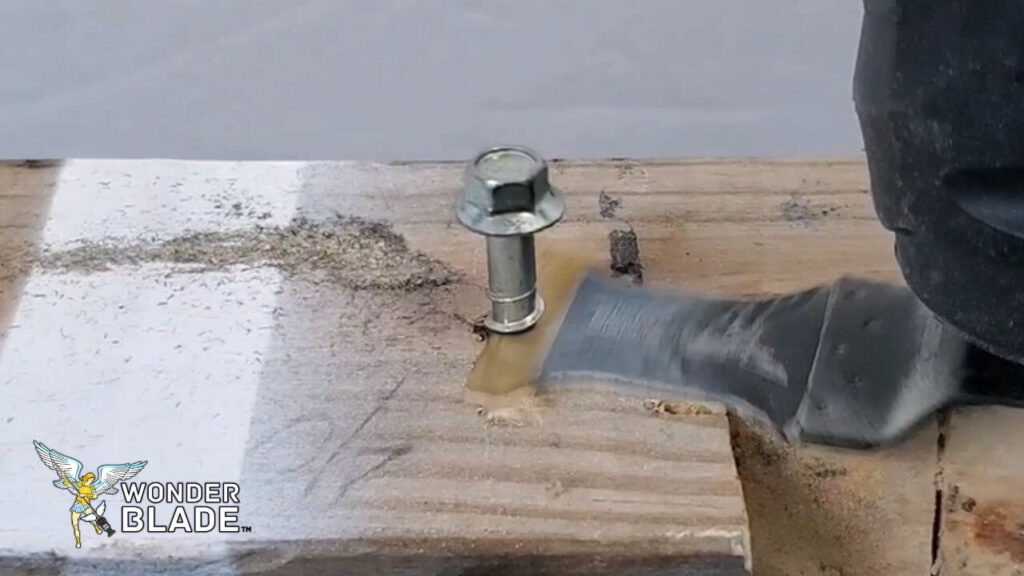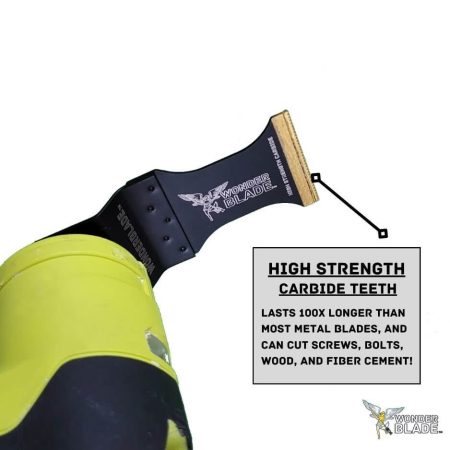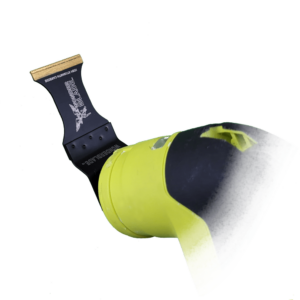
An oscillating tool is a multipurpose electric device used for cutting in a safer manner than regular saws and in hard to reach areas that a regular saw can’t do.
DIYers and professionals may wonder whether an oscillating tool can cut through thicker materials like metal and steel. Can an oscillating tool cut metal?
How about steel?
In this article you’ll going to learn exactly how and if it is possible that an oscillating tool can cut metal or even steel.
Because of their adaptability and usefulness, oscillating tools are becoming more widespread. Surfaces may be swiftly ground, scraped, sliced, sanded, and even polished with the help of portable tools.
The versatility of these tools is unparalleled; you can use them on almost any material, from wood and metal to steel to cement, fiberglass, plastics, masonry, and even drywall.
An oscillating tool works by moving back and forth and was first developed in the 1960s to remove plaster casts from patients, it is today used for various purposes.
You like doing things around the house or making things from scratch. In such a scenario, an oscillating power tool is a better option than a collection of separate equipment.
In addition to cutting metal and steel, oscillating multi-tools can be utilized for various other jobs. These are a few scenarios in which an oscillating multi-tool might come in handy while working with metal:
When cutting metal, employing an oscillating multi-tool is a fantastic way of reducing time and effort without sacrificing precision. But, be sure you use the correct blade, like carbide, and take all necessary safety measures, such as gloves and eye protection.
The cost of these tools is undoubtedly justified. When you can do the work of many different tools with only one, your toolbox may stay compact. If you have an oscillating tool, you can skip using the jigsaw, bolt cutters, grinder, and cutting blades.
Furthermore, an oscillating tool’s versatility also extends to various uses and materials. Because of how compact it is, you won’t have to stress about limited storage space.
Creating clean cuts using an oscillating tool while working with metal and steel is possible. Yet, a good, risk-free cutting experience requires the correct technique and safety measures. Here are some pointers for using an oscillating tool to cut steel and other metals:
Choose the Correct Blade: When using an oscillating tool for metal and steel cutting, choosing the appropriate blade is essential. Blades made of bi-metal or carbide are best for cutting metal are the industry norm. However, this may change depending on the metal’s thickness and hardness.
Keep the Metal Secure: Make sure the metal is firmly in place by screws or a vice before cutting. Because of this, the metal won’t be able to move or slide about as much when being cut, leading to a cleaner finish.
Get Help: An accurate and exact cut or shape may be made with a straight edge or guide. While using a guide, you may cut in a straight line without worrying about losing control of the blade.
Calm Yourself: Avoid burnout by taking frequent rests when using an oscillating tool to cut metal. This will aid in keeping your mind clear and your cuts precise.
Protect Yourself by Wearing the Proper Gear: While using an oscillating tool to cut metal or steel, you must always protect your eyes, hands, and ears. Protecting your eyes, hands, and ears from sparks, dust, and noise is essential while cutting metal.
Managing the Speed: When using an oscillating tool to cut metal and steel, it is crucial to regulate the oscillating tool’s speed. Thinner, softer metals benefit more at slower speeds, whereas thicker, harder metals do better at higher speeds. Try using a few different blades and cutting rates to get the most significant results while cutting metal.
In essence, if you need to make clean, precise cuts in metal or steel, an oscillating tool is an excellent option. To get the most significant outcomes and avoid injury, follow these guidelines. When cutting metal with an oscillating tool, taking your time, using a suitable carbide blade, and protecting yourself adequately are essential.
Cutting metal using an oscillating multitool might involve significantly different methods and processes, depending on the job’s specifics. Have a look at this list of the most typical tasks that require the use of an oscillating tool to cut metal.
Aluminum is one of the lightest metals, and even a beginner can usually cut it with a multitool with little effort. While the industry norm is to use a bi-metal blade, if you have been using oscillating multi tools for a while, you’ll find out that does not tend to work out.
In an emergency, a strong oscillating tool blade like ours at WonderBlade will do the job; nevertheless, its straight cutting edge and tiny teeth may often cause problems. As a result, you’ll have to take breaks from working on your project very often to clear the clutter.

*Save yourself time, money, and hassle with the best oscillating tool blade in the industry that lasts many cuts through wood, screws, fiber cement, sheetrock, plastic, and more.*
Additionally, if you must stop working on your project to remove the burrs and spurs, consider turning off the multitool, unhooking it from the wall outlet, or taking out the batteries. Unless you’re curious about how easily an oscillator can rip off a fingertip.
The major problem with working with aluminum is that it bends and vibrates a lot while being cut with a multitool, making it challenging to perform clean cutting and decreasing cutting speed, thus, you should constantly try to get a tight grip on the specified target zones.
Instead of using a multitool to make long cuts in sheeting, you should use snips, which are portable tools that will provide a more precise trimming line and a smoother edge. For tasks like detailing, cross-cutting, and cornering, oscillating multi tools are ideal for use with metal.
Metal fabricators, engineers, and knowledgeable Do It Yourselfers all know that various types of screws and nuts have varying strengths, which must be considered while selecting the proper blade.
If the blade is too powerful, you risk losing control when cutting and spoiling the finish. Find out which blade is most suited for the number of bolts and screws in your home by reading our advice below.
Use a blade with segments for cutting tiny hardware. Use a plunge-cutting head to remove screws and bolts with a larger diameter. If the bolts are huge, such as those used in shipbuilding, they may be sheared in a single motion without being approached from both sides.
The screw is often already installed and sandwiched between two layers. Because of the small design of a multitool, you may use it in tight spaces where more effective power tools like reciprocators, hacksaws, and angle grinders won’t fit, giving you the stability, you need to shorten or flush the bolt level with the surrounding surface. But if you need to resize a screw or remove the head, do it securely in a high-quality clamp.
Copper is the most frequent metal that DIYers will want to cut since it is used in various applications (for electricians and plumbers especially) and can be easily shaped and enlarged using an oscillating tool. A regular plunge or segmented bi-metal blade will do when the tensile strength doesn’t need to exceed 300 MPa (megapascals).
While a regular carbide blade may be used, it would be like trying to cut bread with a chainsaw. Yet, certain copper alloys, such as beryllium copper (which has mechanical properties of 1000 MPa), have weight and toughness on the level of steel.
You will only run across this medium in DIY projects if you’re working with heavy machinery since this substance is utilized for industrial springs.
Nonetheless, our High-Strength Oscillating Tool can be used to cut tough metals. Copper pipe is often sold in six- or twelve-foot lengths, so you’ll work with lengthy stock if you need to cut it free. To avoid bouncing, place a grip as near to the point of application as feasible, just as you would with aluminum.
Finally, keep in mind that copper is a soft metal. You’ll need some plastic or rubber padding to keep the pipe’s body from being crushed in the vice’s jaws.
Cutting through the majority of steel materials may be accomplished with the help of an oscillating multi-tool. There is a significant difference between the various steel alloys in terms of their durability and hardness and how easily they can be cut. Using cutting blades made of bi-metal or carbide, even the lightest unhardened low-carbon and low-alloy steels may be cut with a reasonable amount of ease.
Although medium-strength toughened steels, used for high-strength grade bolts, are already considerably more challenging, carbide saw blades are the most appropriate tool for cutting through these types of steel. On the other hand, even with carbide blades, certain alloys and tool steels with the maximum possible strength could be difficult or impossible to cut.
Sheet metal may be sliced using an oscillating multi-tool. A bi-metal saw is enough for sheet materials like aluminum, zinc, copper, and mild steel, but for harder metals like toughened steel and stainless steel, a carbide blade is required. The segment saw blades are more stable than plunge-cut blades. However, both types of saws may be utilized.
While working with sheet metal, the most significant difficulty comes from maintaining a steady workpiece. To avoid deforming the sheet too much, sawing forces must be applied at an angle to the sheet’s surface. Because of this bending, the tool may cut poorly, make too much noise, or kick back. This problem becomes much more pronounced with thinner sheets.
In many cases, fastening the sheet along its entire length to the boundary line will provide the necessary stability for cutting. You may also use a thicker piece of plywood as a protective sheet and clamp the thinner sheet against it.
Sheet metal can’t be cut quickly using an oscillating multi-tool. Yet, an oscillating multi-tool is adaptable regarding the materials it can cut and the shapes it can make. It is also safe to use and seldom causes sparks. The cut is also straight and unbent on both sides.
The answer is yes, an oscillating tool can cut metal and steel If you know what you’re doing and take the necessary precautions, an oscillating tool may be a fantastic instrument for cutting metal and steel. With the correct blade and method, you can make clean cuts through various metals and reap the benefits of this efficient and versatile tool.

There are many blades that you’ll find in your local hardware store tend not to last, here at WonderBlade we have an all around General Purpose Oscillating Tool Blade that lasts time and time again against hundreds of cuts through wood, fiber cement, sheetrock, plastic and more*
Submit your questions, thoughts, or concerns to help us make better content just for you:
